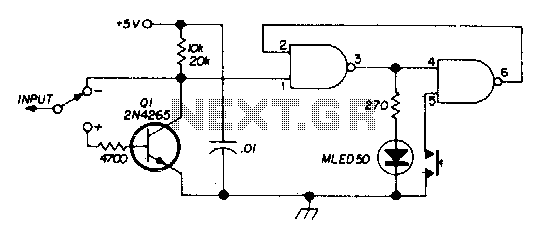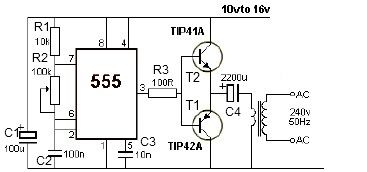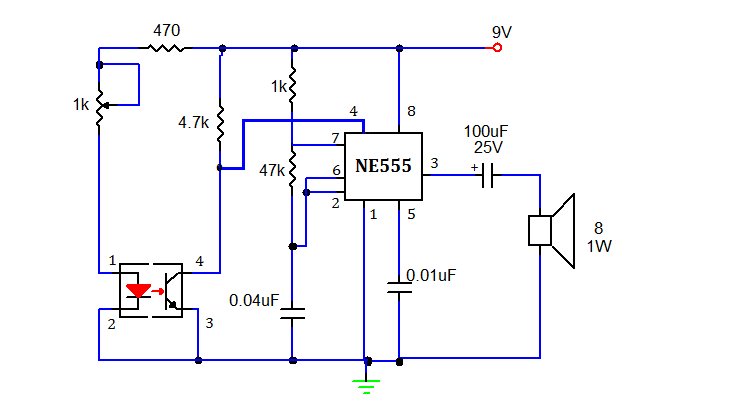
positive negative probe with ic 555

This circuit allows users to determine whether a specific point in the circuit is at a positive or negative voltage. It is an inexpensive circuit that utilizes minimal components, making it suitable for use in automobiles or motorcycles. The circuit operates within a voltage range of 5 to 15 volts. When the circuit is powered, two LEDs light up to indicate the voltage status. If a positive voltage is detected at pin 3 of the IC 555, the red LED illuminates while the green LED turns off. Conversely, if a negative voltage is detected, the red LED turns off and the green LED lights up. A 1N4002 diode is included to protect against reverse polarity. Further details can be found in the accompanying circuit diagram.
This circuit employs an integrated circuit (IC) 555 configured in a comparator mode to differentiate between positive and negative voltages. The circuit's design is straightforward, comprising the IC 555, two light-emitting diodes (LEDs) for visual indication, and a protective diode (1N4002).
The power supply for the circuit is connected across the power pins of the IC, ensuring that it operates within the specified voltage range of 5 to 15 volts. The two LEDs serve as indicators: the red LED signifies the presence of a positive voltage, while the green LED indicates a negative voltage. The operation of the LEDs is controlled by the output of the IC 555, which changes state based on the voltage level detected at its input pin.
When a positive voltage is applied to pin 3 of the IC, the output goes high, activating the red LED and illuminating it. Simultaneously, the green LED is turned off. This visual feedback allows the user to easily ascertain the polarity of the voltage at the test point. On the other hand, when a negative voltage is applied, the output of the IC changes state, turning off the red LED and illuminating the green LED.
The inclusion of the 1N4002 diode is crucial for protecting the circuit from potential damage due to incorrect polarity connections. This diode ensures that the current flows in the correct direction, safeguarding sensitive components within the circuit.
Overall, this circuit is a practical solution for quickly identifying voltage polarity in automotive or motorcycle applications, providing an efficient and low-cost method for users to check voltage levels safely. The simplicity of the design makes it accessible for both novice and experienced electronics enthusiasts.With this circuit you can can check that which dot of the circuit is Positive Volt or Negative Volt which. This cheap circuit uses the a little component is will appropriate apply with an automobile or motorcycle.
This circuit works during Voltage between 5-15V. When build volt supply of circuit LED 2 pcs. of stick bright but enough check meet Pos itive Volt make at pin 3 of IC 555 liberate Negative volt come out cause Red LED stick bright next but Green LED switch off down replace. But when check meet Negative Volt make Red LED switch off but Green LED stick bright replace yes. The Diode 1N4002 be formed protect turning pole electricity over. The detail is other, see in the circuit please sir. 🔗 External reference
This circuit employs an integrated circuit (IC) 555 configured in a comparator mode to differentiate between positive and negative voltages. The circuit's design is straightforward, comprising the IC 555, two light-emitting diodes (LEDs) for visual indication, and a protective diode (1N4002).
The power supply for the circuit is connected across the power pins of the IC, ensuring that it operates within the specified voltage range of 5 to 15 volts. The two LEDs serve as indicators: the red LED signifies the presence of a positive voltage, while the green LED indicates a negative voltage. The operation of the LEDs is controlled by the output of the IC 555, which changes state based on the voltage level detected at its input pin.
When a positive voltage is applied to pin 3 of the IC, the output goes high, activating the red LED and illuminating it. Simultaneously, the green LED is turned off. This visual feedback allows the user to easily ascertain the polarity of the voltage at the test point. On the other hand, when a negative voltage is applied, the output of the IC changes state, turning off the red LED and illuminating the green LED.
The inclusion of the 1N4002 diode is crucial for protecting the circuit from potential damage due to incorrect polarity connections. This diode ensures that the current flows in the correct direction, safeguarding sensitive components within the circuit.
Overall, this circuit is a practical solution for quickly identifying voltage polarity in automotive or motorcycle applications, providing an efficient and low-cost method for users to check voltage levels safely. The simplicity of the design makes it accessible for both novice and experienced electronics enthusiasts.With this circuit you can can check that which dot of the circuit is Positive Volt or Negative Volt which. This cheap circuit uses the a little component is will appropriate apply with an automobile or motorcycle.
This circuit works during Voltage between 5-15V. When build volt supply of circuit LED 2 pcs. of stick bright but enough check meet Pos itive Volt make at pin 3 of IC 555 liberate Negative volt come out cause Red LED stick bright next but Green LED switch off down replace. But when check meet Negative Volt make Red LED switch off but Green LED stick bright replace yes. The Diode 1N4002 be formed protect turning pole electricity over. The detail is other, see in the circuit please sir. 🔗 External reference





